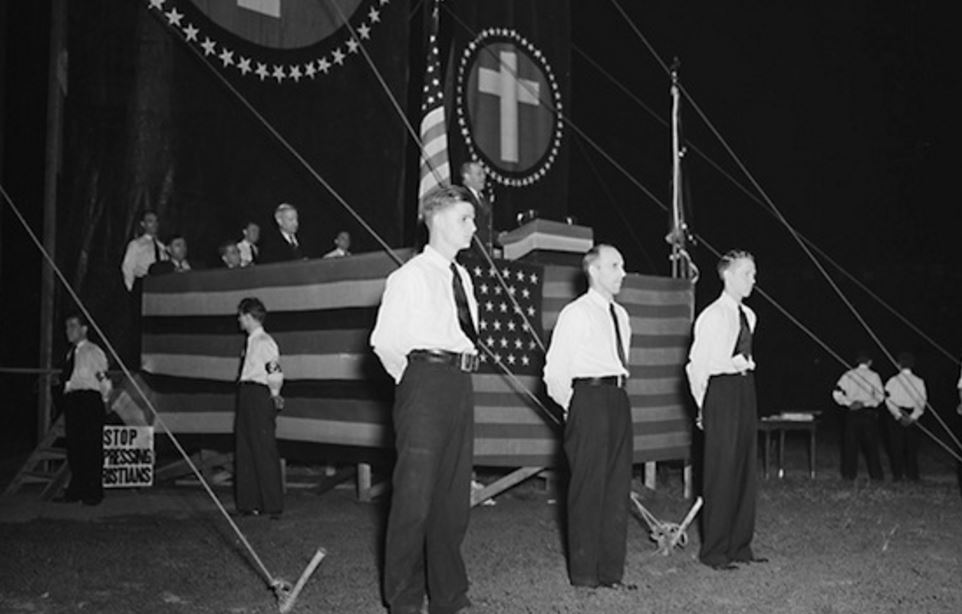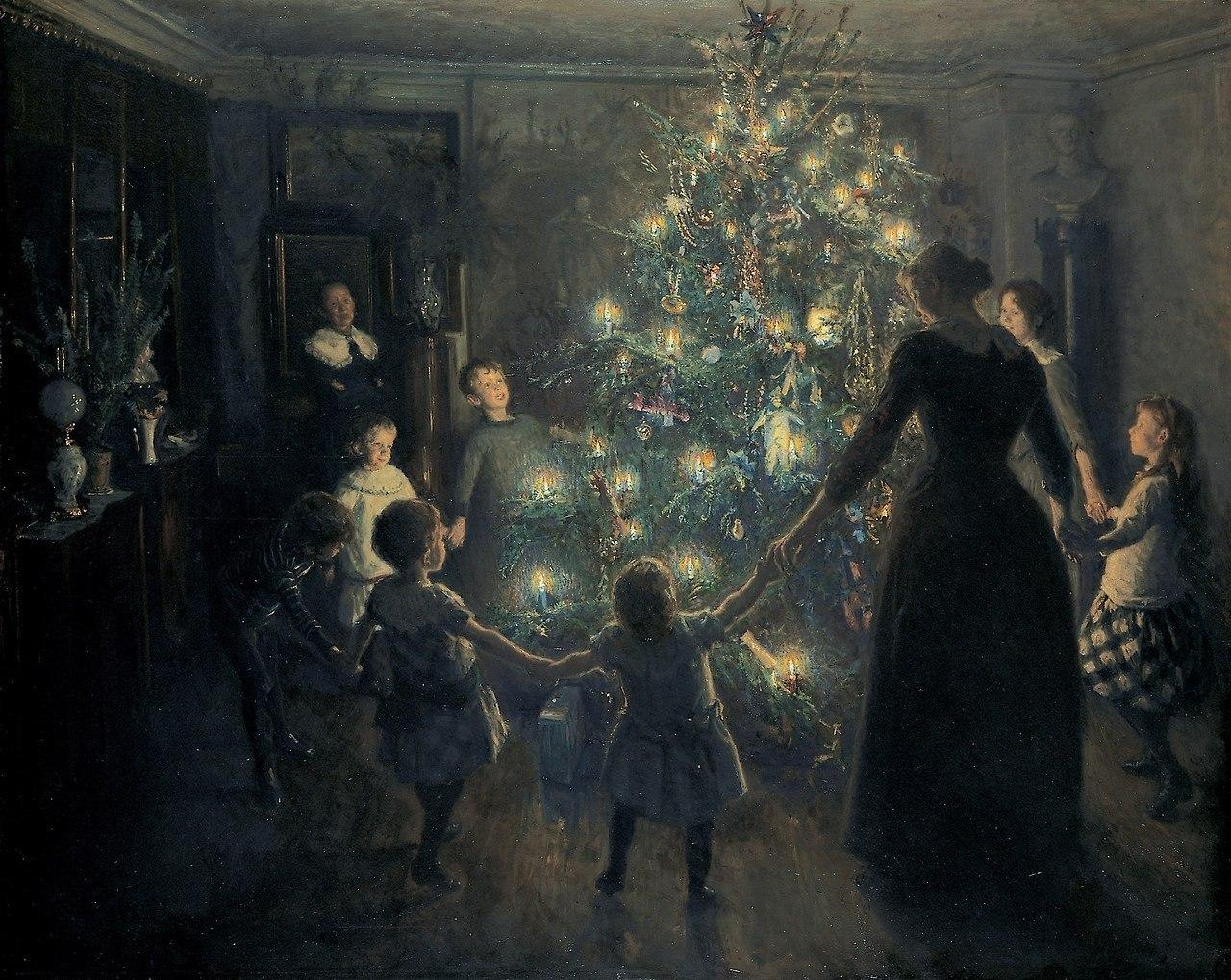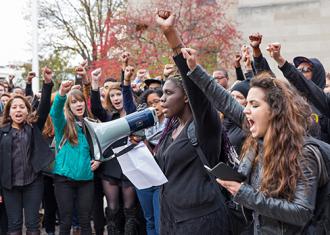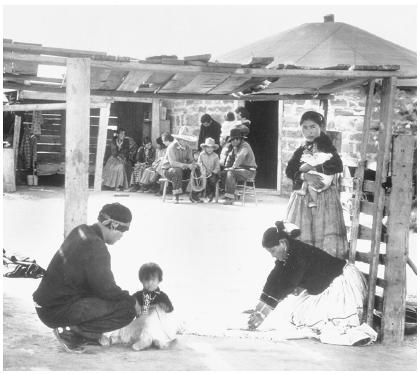TBF
TBF's JournalResistance in a year of fear
... there's the most obvious and widespread expression of people shifting leftward: the Democratic presidential campaign of Bernie Sanders, who is polling at over 30 percent as an open (if quite moderate) socialist in party polls. Sanders, it should be noted, is even with or ahead of Trump and other Republicans in polling on head-to-head matchups.
Donald Trump and his fellow Republican monsters may hog the headlines, but their outrages don't represent the full picture of the political climate in the U.S. today.
December 18, 2015
IN CARTOONS, years are usually drawn as Baby January who becomes frail Old Man December. But as this year ends with a disturbing cycle of public violence and racist fear-mongering, maybe the months of late 2015 will be drawn as a gunman screaming racial slurs.
The violence has come in different forms: there were the ISIS terror attacks on the streets of Paris and Beirut and a Russian passenger plane; right-wing terror attacks in the U.S. against a Colorado Planned Parenthood clinic and a Minneapolis Black Lives Matter protest; a mass shooting at a San Bernardino social service center that seems to have been a fusion of an ISIS-inspired attack and an American-as-apple-pie workplace massacre--and, not to be forgotten, as the media seem to, the biggest wave of violence against Muslims or those believed to be Muslim since the days after the September 11 attacks.
The racist fear-mongering can be seen in a surge of right-wing demagoguery on both sides of the Atlantic--from the unprecedented election gains made by the far-right National Front party in France to Donald Trump's commanding, though still early, lead in the race for the Republican presidential nomination.
These disturbing developments are themselves products of and reactions to more deep-seated instabilities and injustices that many mainstream political leaders generally refuse to recognize, much less address: An economy where living conditions have stagnated or worse for the vast majority of people during the 2008-09 Great Recession and after; and the global chaos caused by the endless U.S. wars on terror and drugs, which is creating the largest refugee crisis the world has seen since the Second World War ...
Much more here: http://socialistworker.org/2015/12/18/resistance-in-a-year-of-fear

When Fascism Was American
Nevertheless, three decades of inequality and austerity have impoverished large sections of the American working class — along with declining US political prestige, bloody military adventures, and pervasive outrage at corruption in mainstream politics — have made a growing number of Americans more receptive to xenophobic and racist appeals that give voice to the powerlessness they feel in the face of hardship.
The past shows that the US is not immune to fascism. We must take the current far-right upsurge seriously and use every tool at our disposal to destroy it.
Before Donald Trump, there was Father Charles Coughlin, who popularized fascism for Americans in the 1930s.
by Joe Allen 12-29-15
The open racism and xenophobia that have characterized Donald Trump’s presidential campaign, and perhaps provided much of its appeal, has been alarming. For a growing number of people, Trump’s rhetoric is a sign of something deeper and more frightening: the growth of a fascist movement in the United States.
Ohio governor John Kasich — one of Trump’s many rivals for the Republican nomination — produced an anti-Trump video that paraphrases Protestant theologian Dietrich Bonhoeffer’s warning about the Nazis.
For many other commentators, as well, the violence Trump supporters have directed at critics during campaign rallies, along with the candidate’s call for banning Muslims from the United States, are further confirmation that Trump is a Nazi. In the last Democratic presidential debate, former Maryland governor and presidential candidate Martin O’Malley denounced Trump as a “fascist demagogue.”
<snip>
The US hasn’t seen the stirrings of fascist mobilization since the late 1930s when mounting fascist victories in Europe galvanized its adherents in America, chief among them Father Charles Coughlin and his Christian Front. This history has something to offer us today ...
Much more here: https://www.jacobinmag.com/2015/12/trump-coughlin-nazis-christian-front-kristallnacht-antisemitism-kasich-fascism/

How the Wall Fell
Thus, East Germans today enjoy democratic freedoms and cultural modernization, but are subjected to internal colonization as well as mass unemployment — a contradiction that also applies to the radical changes that occurred in other parts of Eastern Europe.
The Berlin Wall’s fall sparked dreams of a radically democratic East Germany. Unemployment and privatization followed instead.
by Bernd Gehrke 12-27-15
This fall marks the twenty-fifth anniversary of German reunification, the culmination of what the dominant narrative of the period calls the “Peaceful Revolution,” beginning with the popular uprisings in October–November 1989. In East German vernacular, this radical break with the Stalinist dictatorship is known as the Wende (“turn”), but in the political sense carries a meaning more akin to “change.”
Neither of these framings quite capture the contradictions of reunification and the way in which they prefigured similar developments in the process of European unification.
The political transformation of East Germany occurred at a remarkable speed — within a year the Stalinist political system of the German Democratic Republic (GDR) had not only collapsed, but been united with the West German state. This political unification was followed by an equally fast economic unification, which sparked an unprecedented wave of deindustrialization over the next three or four years.
Thus Germany experienced its own type of the Mezzogiorno effect: the new federal states of the East became in many ways analogous to southern Italy, characterized by high unemployment, low or even negative economic growth, and financial dependence on subsidies from the rest of the country. Not surprisingly, more than two million (out of a pre-Wende population of seventeen million) easterners have left the region since reunification, a number approaching the amount of refugees who fled the country before the construction of the Berlin Wall in 1961 ...

Much more here: https://www.jacobinmag.com/2015/12/reunification-east-germany-berlin-wall-unification-gdr-stasi/
Oh Tannenbaum
As long as America has had Christmas trees, people have used them to tell other people who does and doesn’t matter, celebrating communal joy narrowly, sometimes belligerently, at somebody else’s expense. Let us therefore celebrate the equally venerable tradition of Christmas tree dissent!
December 16, 2015 | by Alison Kinney
Christmas trees have served as political lightning rods for nearly as long as Americans have been decorating them.
In 1937, the Federal Writers’ Project interviewed Junius Quattlebaum, who’d grown up enslaved in South Carolina, about his Christmas memories. He spoke of gathering around the Christmas tree to take his share of the "candy, apples, raisins, and nuts for all de chillum … Christmas morning, marster would call all de slaves to come to de Christmas tree. He made all de chillun set down close to de tree and de grown slaves jined hands and make a circle ’round all … missus would stand in de middle of the de ring and raise her hand and bow her head in silent thanks to God. All de slaves done lak her done".
Frederick Douglass denounced such parties as being “among the most effective means in the hands of the slaveholder in keeping down the spirit of insurrection … These holidays serve as conductors, or safety-valves, to carry off the rebellious spirit of enslaved humanity.” The white South Carolinian William J. Grayson rhapsodized in his 1856 poem “The Hireling and the Slave” about the “smile and bow” and “abundant cheer” of the slave’s Christmas: “No ennui clouds, no coming cares annoy, / Nor wants nor sorrow check the Negro’s joy,” for “In all his master’s joys he claims a part.” Yet for all their paternalism, slave owners betrayed a suspicion that the pleasure in Christmas wasn’t mutual, and that slaves might not be satisfied with raisins: Christmas was the time when white Southerners spread the wildest rumors of slave insurrection, restocked their ammunition, and built hiding places in the woods.
Grayson may well have sympathized with LeAnn Rimes Cibrian, the country singer who upstaged her own performance last year at the lighting of the Rockefeller Center Christmas Tree with a tweet: “Wow, riots are sad tonight coming out of a joyous place. #peaceatchristmas #prayersforall.” The “riots” she referred to were the peaceful protests of the non-indictment of the police officer responsible for Eric Garner’s death earlier in 2014.
I’m an atheist, but I love Christmas trees as much as—or probably a lot more than—the next celebrant. After I assembled a new gold and silver tinsel tree in my Brooklyn apartment last December, I never took it down; a year later, it’s dusty but still radiant. I collect souvenir ornaments and Italian nativity figures; I’ve sewn my own tree skirt and stocking and made my own Caga tío, the Catalan hazelnut-pooping Christmas log. I can almost understand the temptation, then, to insulate Christmas trees from politics: to retain the presumably pure, innocent, childlike wonder of Christmas iconography. But as any good folklorist will tell you, Christmas trees in America have always come with tumult: the apocryphal first Christmas trees on U.S. soil were decorated by the Hessian mercenaries the British had hired to kill American insurgents. “We won’t go until we get some!” ...
More here: http://www.theparisreview.org/blog/2015/12/16/oh-tannenbaum/

Free Speech
Campus protesters are being criticized for squelching free speech, but the right wingers leading the attack are really concerned about protecting the right to be a racist.
But this media smear fits a familiar pattern: When Black people raise their voices against oppression, a reason is quickly found to prove how they are being oppressors. Just as Republicans falsely insisted for years that African Americans going to vote were committing voter fraud, now Black students speaking out against racism are accused of silencing others.
They don't want to hear our free speech
December 3, 2015
THE NEW movement against anti-Black racism took another step forward in November when protests burst out on college campuses across the country.
Many of these actions were inspired by the powerful University of Missouri (Mizzou) demonstrations that gained national attention when the football team threated to go on strike unless the university president resigned. But all focused on the impact of institutional racism specific to each campus.
At dozens of rallies, sit-ins and occupations, students talked about being profiled and harassed by campus police, the stress of feeling more like a token of diversity than a fully accepted student, and the lack of support from universities they are putting themselves into decades-long debt just to attend.
This eruption of struggle on campuses is clearly an expression of anger and pain that has simmered away for years beneath the well-maintained surfaces of college life. Yet to many hostile observers, the protests somehow represent the opposite: a suppression of the right to free expression ...
Much more here: http://socialistworker.org/2015/12/03/they-dont-want-to-hear-our-speech

Environmentalism for the Left
From Midwestern farms to pristine suburbs to public acreage, American landscapes are a monument to a history of inequality, hierarchy, and exclusion. And they are informed at every point by moral and political conceptions of the natural world—often undemocratic in origin and effect—whose advocates tended to deny that they were political at all.
An Environmentalism for the Left
Jedediah Purdy ▪ Fall 2015
Although modern environmental politics emerged in the radical ferment of the early 1970s, leftists were suspicious from the outset of its easy mainstream appeal and its elite constituency. The same doubts persist today. The venerable Nature Conservancy’s close partnerships with corporations and focus on “ecosystem services” that can be monetized are just one reminder that environmentalism’s institutional mainstream fits comfortably with neoliberalism. Consumerist appeals to eco-consciousness (think of the local-sourcing policies and the prices of anti-union Whole Foods) suggest that environmentalism is about image and market choices. Despite decades of talk about environmental justice, the movement remains disproportionately white, elite, and motivated by romantic attachment to high mountains, old forests, and charismatic animals. Even treating climate change as an “environmental” question obscures issues of global justice—the ways that the world’s rich are much more responsible for, and less vulnerable to, the problem than the poor.
What would an environmentalism of the left look like?
It would first of all have to change its attitude to “nature.” Environmentalism is the youngest generation of a longer-running politics of nature. This politics pivots on contested visions of nature’s value, humanity’s place in it, and what, in fact, “nature” even is. From the preservationist movement that helped create national parks and wilderness areas to the awareness of ecological interconnection that inspired the anti-pollution laws of the 1970s, the politics of nature has often been democratic and creative in advancing the notion of the living world as part of a human ecology. But the politics of nature has also been an anti-politics, appealing to “nature” to shut down democratic debate ...
Much more here: https://www.dissentmagazine.org/article/after-nature-left-environmentalism-jedediah-purdy

Indian Resistance and Thanksgiving Declarations
The United States government had signed more than four hundred treaties with Indians and violated every single one.
I speak to you as a Man-a Wampanoag Man….It is with mixed emotions that I stand here to share my thoughts….The Pilgrims had hardly explored the shores of Cape Cod four days before they had robbed the graves of my ancestors, and stolen their corn, wheat, and beans….Our spirit refuses to die. Yesterday we walked the woodland paths and sandy trails. Today we must walk the macadam highways and roads. We are uniting. We’re standing not in our wigwams but in your concrete tent. We stand tall and proud and before too many moons pass we’ll right the wrongs we have allowed to happen to us….
Indian Resistance and Thanksgiving Declarations
Posted on November 17, 2014 by Howard Zinn Website
For a time, the disappearance or amalgamation of the Indians seemed inevitable—only 300,000 were left at the turn of the century, from the original million or more in the area of the United States. But then the population began to grow again, as if a plant left to die refused to do so, began to flourish. By 1960 there were 800,000 Indians, half on reservations, half in towns all over the country.
The autobiographies of Indians show their refusal to be absorbed by the white man’s culture. One wrote:
Oh, yes, I went to the white man’s schools. I learned to read from school books, newspapers, and the Bible. But in time I found that these were not enough. Civilized people depend too much on man-made printed pages. I turn to the Great Spirit’s book which is the whole of his creation….
A Hopi Indian named Sun Chief said:
I had learned many English words and could recite part of the Ten Commandments. I knew how to sleep on a bed, pray to Jesus, comb my hair, eat with a knife and fork, and use a toilet. … I had also learned that a person thinks with his head instead of his heart ...
Much more here: http://howardzinn.org/indian-resistance-thanksgiving-declarations/

Supreme Court and Labor
High court tackles four important cases involving workers, unions
by: Mark Gruenberg
November 20 2015
WASHINGTON (PAI) - From affirmative action to agency fees to whistleblower rights, a spate of worker-oriented cases either wound up before the U.S. Supreme Court in November, or are headed there, with the opposing sides laying out their positions this past month.
And while most of labor focuses on one of the looming conflicts - the agency-fee case Friedrichs vs. California Teachers Association - the others are important, too.
That's because the court, and particularly its five-man Republican-named majority, appears poised to drastically rewrite not just labor law, but working conditions in the U.S.
The class action and worker pay case ...
Details about each of the four cases here: http://peoplesworld.org/high-court-tackles-four-important-cases-involving-workers-unions/

Profile Information
Gender: FemaleHometown: Wisconsin
Current location: Tejas
Member since: Thu Jan 17, 2008, 01:44 PM
Number of posts: 32,055

